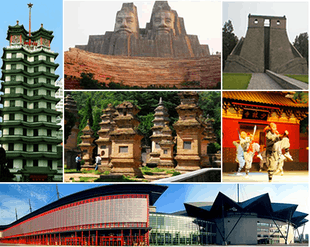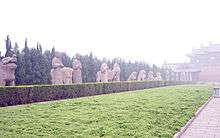Zhengzhou
| Zhengzhou 郑州 | |
|---|---|
| Prefecture-level city | |
|
Clockwise from top left: Erqi Memorial Tower, Emperors Yan and Huang, Dengfeng Observatory, Shaolin Monastery, Zhengzhou Exhibition Center; and Center: The Pagoda Forest at the Shaolin Temple | |
| Nickname(s): business city, green city | |
| Motto: Partnership, Openness, Innovation, and Harmony (博大、开放、创新、和谐) | |
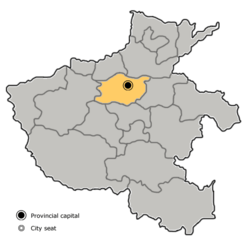 Location of Zhengzhou City; jurisdiction in Henan | |
 Zhengzhou Location in China | |
| Coordinates: 34°46′N 113°39′E / 34.767°N 113.650°ECoordinates: 34°46′N 113°39′E / 34.767°N 113.650°E | |
| Country | China |
| Province | Henan |
| City seat | Zhongyuan |
| Subdivisions | |
| Government | |
| • Mayor | Ma Yi |
| Area | |
| • Prefecture-level city | 7,507 km2 (2,898 sq mi) |
| • Urban | 1,024 km2 (395 sq mi) |
| • Metro | 1,979 km2 (764 sq mi) |
| Population (2015)[1] | |
| • Prefecture-level city | 9,568,000 |
| • Density | 1,300/km2 (3,300/sq mi) |
| • Urban | 6,406,000 |
| • Urban density | 6,300/km2 (16,000/sq mi) |
| GDP (2015) | |
| • Total GDP |
C¥ 731.5 billion (US$117.5 billion) |
| • Per capita |
CN¥ 77,217 (US$12,397) |
| Time zone | China Standard (UTC+8) |
| Postal code | 450000 |
| Area code(s) | 371 |
| License plate prefixes | 豫A |
| Website |
www |
| Zhèngzhōu | |||||||||||||||||||||||||||
.svg.png) "Zhèngzhōu" in Simplified (top) and Traditional (bottom) Chinese characters | |||||||||||||||||||||||||||
| Simplified Chinese | 郑州 | ||||||||||||||||||||||||||
|---|---|---|---|---|---|---|---|---|---|---|---|---|---|---|---|---|---|---|---|---|---|---|---|---|---|---|---|
| Traditional Chinese | 鄭州 | ||||||||||||||||||||||||||
| Postal | Chengchow | ||||||||||||||||||||||||||
| Literal meaning | "Zhèng Settlement" | ||||||||||||||||||||||||||
| |||||||||||||||||||||||||||
Zhengzhou is a Chinese city and the provincial capital of Henan Province in east-central China.[2] As a prefecture-level city, it also serves as the political, economic, technological, and educational centre of the province, as well as a major transportation hub for Central China. The city lies on the southern bank of the Yellow River, and is one of the Eight Great Ancient Capitals of China.[3]
Zhengzhou has a population of 9,378,000 inhabitants with an urban population of 6,406,000,[4] the city is one of the main built up areas of Henan region.[5] Zhengzhou is now a rapidly growing city.
Greater Zhengzhou was named as one of the 13 emerging megacities or megalopolises in China in a July 2012 report by the Economist Intelligence Unit.[6]
History
The Shang dynasty established Aodu (隞都) or Bodu (亳都) in Zhengzhou.[7] This prehistorical city had become abandoned as ruins long before the First Emperor of China in BC 260. Since 1950, archaeological finds in a walled city in Eastern Zhengzhou have provided evidence of Neolithic Shang dynasty settlements in the area.[8][9] Outside this city, remains of large public buildings and a complex of small settlements have been discovered. The site is generally identified with the Shang capital of Ao and is preserved in the Shang dynasty Ruins monument in Guanchen District. The Shang, who continually moved their capital due to frequent natural disasters, left Ao at around 13th century BC. The site, nevertheless, remained occupied; Zhou (post-1050 BC) tombs have also been discovered.[10] Legend suggests that in the Western Zhou period (1111–771 BC) the site became the fief of a family named Guan. From this derives the name borne by the county (xian) since the late 6th century BC—Guancheng (City of the Guan). The city first became the seat of a prefectural administration in AD 587, when it was named Guanzhou. In 605 it was first called Zhengzhou—a name by which it has been known virtually ever since.[11]
The name Zhengzhou came from the Sui dynasty (AD 581), even though it was located in Chenggao, another town. The government moved to the contemporary city during the Tang dynasty. It achieved its greatest importance under the Sui (AD 581–618), Tang (618–907), and early Song (960–1127) dynasties, when it was the terminus of the New Bian Canal, which joined the Yellow River to the northwest. There, at a place called Heyin, a vast granary complex was established to supply the capitals at Luoyang and Chang'an to the west and the frontier armies to the north. In the Song period, however, the transfer of the capital eastward to Kaifeng robbed Zhengzhou of much of its importance. It was a capital during the five dynasties of Xia, Shang, Guan, Zheng, and Han, and a prefecture during the eight dynasties of Sui, Tang, Five Dynasties, Song, Jin, Yuan, Ming, and Qing.
In 1903 the Beijing–Hankou Railway arrived at Zhengzhou, and in 1909 the first stage of the Longhai Railway gave it an east–west link to Kaifeng and Luoyang; it later was extended eastward to the coast at Lianyungang, Jiangsu, and westward to Xi'an (Chang'an), Shaanxi, as well as to western Shaanxi. Zhengzhou thus became a major rail junction and a regional center for cotton, grain, peanuts, and other agricultural produce. Early in 1923 a workers' strike began in Zhengzhou and spread along the rail line before it was suppressed; a 14-story double tower in the center of the city commemorates the strike. On June 10, 1938, Chiang Kai-shek's National Revolutionary Army opened up the dikes retaining the Yellow River at Huayuankou between Zhengzhou and Kaifeng, in an effort to stem the tide of invading Japanese; however, the ensuing 1938 Yellow River flood also killed hundreds of thousands of Chinese.[12]
Zhengzhou also has a locomotive and rolling-stock repair plant, a tractor-assembly plant, and a thermal generating station. The city's industrial growth has resulted in a large increase in the population, coming predominantly from industrial workers from the north. A water diversion project and pumping station, built in 1972, has provided irrigation for the surrounding countryside. The city has an agricultural university.
Administration and demography
Zhengzhou is divided into 6 urban districts, 5 county-level cities and 1 county. These subdivisions are likely to undergo a significant change in the near future due to rapid urban expansion and urban planning.
The municipality is home to 8,626,505 inhabitants (2010 census) and over four million in its built up area, making the city one of the main built-up areas of the province.[5]
| Map | |||||
|---|---|---|---|---|---|
| Name | Simplified Chinese | Hanyu Pinyin | Population (2010) |
Area (km2) | |
| City proper | |||||
| Jinshui District | 金水区 | Jīnshuǐ Qū | 1,588,611 | 242 | |
| Erqi District | 二七区 | Èrqī Qū | 712,597 | 159 | |
| Huiji District | 惠济区 | Hùijì Qū | 269,561 | 206 | |
| Guancheng Hui District | 管城回族区 | Guǎnchéng Huízú Qū | 645,888 | 204 | |
| Zhongyuan District | 中原区 | zhōngyuán Qū | 905,430 | 195 | |
| Suburban | |||||
| Shangjie District | 上街区 | Shàngjiē Qū | 131,540 | 64.7 | |
| Satellite cities | |||||
| Xingyang | 荥阳市 | xíngyáng Shì | 613,761 | 908 | |
| Xinzheng | 新郑市 | Xīnzhèng Shì | 758,079 | 873 | |
| Dengfeng | 登封市 | Dēngfēng Shì | 668,592 | 1220 | |
| Xinmi | 新密市 | Xīnmí Shì | 797,200 | 1001 | |
| Gongyi | 巩义市 | Gǒngyì Shì | 807,857 | 1041 | |
| Rural | |||||
| Zhongmu County | 中牟县 | Zhōngmù Xiàn | 727,389 | 1393 | |
Geography
Located just north of the province's centre and south of the Yellow River, Zhengzhou borders Luoyang to the west, Jiaozuo to the northwest, Xinxiang to the northeast, Kaifeng to the east, Xuchang to the southeast, and Pingdingshan to the southwest. With the land within its administrative borders generally sloping down from west to east, Zhengzhou is situated at the transitional zone between the North China Plain to the east and the Song Mountains and Xionger Mountains to the west, which are part of the greater Qinling range. The city centre is situated to the south of the middle reach of the Yellow River, where its valley broadens into the great plain. Zhengzhou is at the crossing point of the north–south route skirting the Taihang Mountains and the mountains of western Henan. The prefecture spans 34° 16' ~ 34° 58 N latitude and 112° 42' ~ 114° 14' E longitude, covering a total area of 7,446.2 square kilometres (2,875.0 sq mi), including the metropolitan area, which covers 1,013.3 km2 (391.2 sq mi), and the city centre, which occupies 147.7 square kilometres (57.0 sq mi).
The section of the Yellow River flowing through the prefecture extends 150.4 km (93.5 mi). Mountains loom over the western counties of Gongyi and Dengfeng while the easternmost county of Zhongmou is a vast, fertile floodplain, with the counties in between being hilly transitions.
Climate
Zhengzhou experiences a monsoon-influenced, four-season humid subtropical climate (Köppen climate classification Cwa), with cool, dry winters and hot, humid summers. Spring and autumn are dry and somewhat abbreviated transition periods. The city has an annual mean temperature of 14.35 °C (57.8 °F), with the monthly 24-hour average temperature ranging from 0.1 °C (32.2 °F) in January to 27.0 °C (80.6 °F) in July. The frost-free period lasts on average 220 days. Extremes since 1951 have ranged from −17.9 °C (0 °F) on 2 January 1955, 27 December 1971 and 1 February 1990 to 43.0 °C (109 °F) on 19 July 1966.[13][14]
Rainfall is primarily produced by the monsoonal low during summer; in winter, when the vast Siberian High dominates due to radiative cooling from further north, the area receives little precipitation. During the summer season, the city is also often affected by tropical depressions, which bring additional amounts of rain. The annual precipitation is about 630 millimetres (25 in). With monthly percent possible sunshine ranging from 45 percent in February and March to 54 percent in May, the city receives 2,182 hours of sunshine per year, which is just under half the possible total.
| Climate data for Zhengzhou (1971−2000) | |||||||||||||
|---|---|---|---|---|---|---|---|---|---|---|---|---|---|
| Month | Jan | Feb | Mar | Apr | May | Jun | Jul | Aug | Sep | Oct | Nov | Dec | Year |
| Record high °C (°F) | 21.0 (69.8) |
25.2 (77.4) |
29.2 (84.6) |
37.2 (99) |
38.5 (101.3) |
42.3 (108.1) |
43.0 (109.4) |
40.1 (104.2) |
37.9 (100.2) |
34.6 (94.3) |
27.0 (80.6) |
23.8 (74.8) |
43 (109.4) |
| Average high °C (°F) | 5.7 (42.3) |
8.6 (47.5) |
14.0 (57.2) |
21.7 (71.1) |
27.2 (81) |
31.6 (88.9) |
31.8 (89.2) |
30.5 (86.9) |
26.7 (80.1) |
21.5 (70.7) |
14.1 (57.4) |
8.0 (46.4) |
20.1 (68.2) |
| Daily mean °C (°F) | 0.1 (32.2) |
2.7 (36.9) |
8.0 (46.4) |
15.5 (59.9) |
21.0 (69.8) |
25.7 (78.3) |
27.0 (80.6) |
25.6 (78.1) |
21.0 (69.8) |
15.1 (59.2) |
8.0 (46.4) |
2.2 (36) |
14.3 (57.7) |
| Average low °C (°F) | −4.3 (24.3) |
−1.9 (28.6) |
2.9 (37.2) |
9.5 (49.1) |
14.7 (58.5) |
19.8 (67.6) |
22.8 (73) |
21.7 (71.1) |
16.2 (61.2) |
9.9 (49.8) |
3.1 (37.6) |
−2.4 (27.7) |
9.3 (48.8) |
| Record low °C (°F) | −17.9 (−0.2) |
−17.9 (−0.2) |
−7.5 (18.5) |
−1.4 (29.5) |
3.1 (37.6) |
10.3 (50.5) |
15.1 (59.2) |
13.2 (55.8) |
5.0 (41) |
−1.5 (29.3) |
−13.1 (8.4) |
−17.9 (−0.2) |
−17.9 (−0.2) |
| Average precipitation mm (inches) | 8.8 (0.346) |
12.0 (0.472) |
28.5 (1.122) |
39.6 (1.559) |
58.0 (2.283) |
62.8 (2.472) |
155.5 (6.122) |
112.5 (4.429) |
77.4 (3.047) |
45.1 (1.776) |
22.3 (0.878) |
9.8 (0.386) |
632.3 (24.892) |
| Average precipitation days (≥ 0.1 mm) | 3.3 | 4.3 | 6.2 | 6.6 | 6.8 | 7.7 | 11.6 | 9.9 | 8.2 | 6.8 | 5.0 | 3.5 | 79.9 |
| Average relative humidity (%) | 61 | 61 | 63 | 61 | 62 | 62 | 78 | 81 | 75 | 70 | 66 | 61 | 66.8 |
| Mean monthly sunshine hours | 144.3 | 139.0 | 164.8 | 202.8 | 234.0 | 229.5 | 199.9 | 199.6 | 179.2 | 182.4 | 158.3 | 148.1 | 2,181.9 |
| Percent possible sunshine | 46 | 45 | 45 | 52 | 54 | 53 | 45 | 48 | 48 | 52 | 51 | 49 | 49 |
| Source #1: China Meteorological Administration[15] | |||||||||||||
| Source #2: Weather China[16] | |||||||||||||
Air pollution
As air pollution in China is at an all-time high, several northern cities are among one of the most polluted cities and has one of the worst air quality in China. Reporting on China's Airpocalypse has been accompanied by what seems like a monochromatic slideshow of the country's several cities smothered in thick smog. According to a survey made by "Global voices China" in February 2013, Zhengzhou is among China's 10 most polluted cities. Other cities on the blacklist includes major Chinese cities like Beijing, Jinan, Shijiazhuang, and 6 other prefectural cities all in Hebei Province.[17]
According to a report by Greenpeace in 2015, Henan (the province that Zhengzhou is in) has the most severe air pollution in among all the provinces in China with an average PM2.5 concentration of 103.3μg/m3. Ranking second and third respectively are provinces of Hubei and Hebei, with PM2.5 concentrations of 99.2μg/m3 and 98.4μg/m3.[18]
Zhengzhou is the fourth most polluted city air-wise in China, with PM2.5 concentration of 134.7μg/m3 (over 13 times the safe limit established by the WHO) during the first quarter of 2015. Other cities in Henan that ranked within the top 30 most polluted cities in China during the first quarter of 2015 include Xinxiang, Jiaozuo, Anyang, Pingdingshan, Zhoukou, Xuchang, Puyang, and Luoyang; all with PM2.5 concentrations above 100μg/m3.[18]
Sister Cities
Main sights
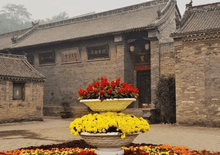
Zhengzhou was the national capital of China during the Shang dynasty. Parts of the Shang-era capital city wall that were built 3,600 years ago still remain in Downtown Zhengzhou (Shangcheng Road 商城路).[11] Zhengzhou maintains abundant its cultural heritage that reflects its glorious history as well as the culture of Henan Province. Zhengzhou Confucius Temple, initially built during the Eastern Han dynasty 1900 years ago, is one of the oldest Confucian Temples in China; other important architectural heritage sites in the city include Town God Temple and Erqi Memorial Tower.
The internationally known tourist attraction is the Shaolin Temple, which is more than 50 miles (80 kilometres) southwest of downtown Zhengzhou (1.5 hours by coach). The Shaolin Temple is not only known as one of China's important Buddhist shrines, but also as the ancient center of Chinese Kung-fu. Shaolin Monastery and its famed Pagoda Forest were inscribed as a UNESCO World Heritage Site in 2010.[19]
The Henan Museum is one of China's most important museums which includes exhibits from prehistoric times, including dinosaur fossils, prehistoric human remains, up through the Modern Eras.
Zhengzhou Zoo (郑州动物园) is located on Huayuan Road (花园路). The newly built Zhengzhou Botanic Garden is at the western edge of Zhengzhou city.
Other attractions of Zhengzhou include
- the Song Mountain (Song Shan, now is a World Geopark where Shaolin Temple is located, also recognised by UNESCO)
- the Yellow River
- the birthplace of Yellow Emperor, recognized as the ancestor of Chinese people.
- Shaolin Monastery, a Buddhist Monastery
- Yu opera
- Zhongyuan Tower
- Henan Provincial Museum
- Peach Valley Resort
- Yellow River Scenic Area
Economy
Zhengzhou, along with Xi'an, Chengdu, Chongqing and Wuhan, is one of the most important cities in inland China. It is the second largest city in central China, after Wuhan. It is the economic center of the province and the surrounding areas such as southeastern Shanxi and southwestern Shandong. Due to its strategic location in one of the most populous areas in the world (nearly 100 million people in Henan alone) and in China's railway, road and aviation transport networks, Zhengzhou is increasingly attracting domestic and international investment as well as migrants from other areas, transforming the city into one of the largest economic centers in China. GDP per capita of Zhengzhou was RMB40,398 in 2008.[20]
Agriculture
By the end of 2006, Zhengzhou had a total population of over 7 million, of which 2.88 million lived in rural areas.[21] Its main products include apples, paulownia, tobacco, maize, cotton, and wheat. In addition, Zhengzhou also produces Yellow River carp, Zhengzhou watermelons, Xinzheng jujube, [Xingyang] dried persimmons, Guangwu Pomegranate and Zhongmu garlic, all of which are specialties that are rarely found outside the region.
Mining and manufacturing
Zhengzhou and the surrounding area have large reserves of coal and other minerals. Coal mining and electricity generation are traditionally important in the local economy.
Zhengzhou has been one of the major industrial cities in The People's Republic of China since 1949. The city's staple industry is textiles. Others manufactured items include tractors, locomotives, cigarettes, fertilizer, processed meats, agricultural machinery, and electrical equipment. Some high-tech companies in new material, electronics and biotechnology are also growing rapidly during the recently years, especially in the high-tech industrial park in the northwest of the city.
- Yutong, China's largest bus producer.
- Shaolin Bus, a well-known small-to-medium-sized bus producer.[22]
- Zhengzhou Nissan, a subsidiary of Dongfeng Nissan, specializing in the manufacture of SUVs and pickup trucks. In 2010, Nissan opened its second plant in the city.[23]
- Zhengzhou Unique Industrial Equipment Co., Ltd., a large tractor and agricultural equipment manufacturer.
Services
The service industries of Zhengzhou include retail, wholesale, hospitality, finance, exhibition, transport and delivery, tourism, and education. With a number of domestic and international institutions having regional offices in the city, Zhengzhou is becoming the financial center in central China. Zhengzhou Commodity Exchange (ZCE) is one of the only three future exchanges (inc. Shanghai Futures Exchange and Dalian Commodity Exchange) in China and is becoming an important global player specialised in agricultural future exchange. Equipped with newly built facilities such as Zhengzhou International Conference and Exhibition Center. Third party logistics (3PL) in Zhengzhou has also been experiencing industrial boom during the past few years. As a transit and tourist center of Henan Province and central China, Zhengzhou is the center of Henan cuisine.
- Dennis, a regional retail chain.
- Henan Construction, a large real estate developer, which owns one of the China Super League's soccer clubs.
Economic development Zones

The Zhengdong New Area, also known as Zhengzhou Eastern New District, similar to Hangzhou Bay New Area in Ningbo and Hengqin New Area in Zhuhai, is just one of dozens of major economic zones that are currently developing in various regions of China.[24]
The provincial and municipal governments established and developed Zhengdong New Area, Mr. Kisho Kurokawa, a Japanese world-renowned planner and architect, was appointed to design the overall planning scheme for Zhengdong New Area.[25] He brought in advanced ideas including ecological city, co-existing city, metabolic city and ring city ideas. The scheme won the "Prominent Award for City Planning Design" at the first session of Annual Meeting of the World Architects Alliance in 2002.
Currently, a six-star hotel in the CBD is being built. When finished, the hotel building, with a height of 280 meters, will become the tallest building in Zhengzhou.
Industrial zones
- Zhengzhou New & Hi-Tech Industries Development Zone
Zhengzhou High & New Technology Industries Development Zone was established in 1988, and approved by the state Council of PRC to be a state development zone on Mar.6,1991. It was appraised to be advanced high tech zone of China respectively in 1993, 1998 and 2002. The Zone currently covers a total area of 18.6 square kilometres (7.2 square miles). An extension plan was approved by Zhengzhou Municipal Government, the various construction work started in 2004. Under the development strategy of “multiple parks in one zone”, the Zone has been making great efforts to promote the development of software,information technologies, new materials, bio-pharmaceutical and photo-machinery-electronic industries.[26]
- Zhengzhou Economic and Technological Development Zone
Zhengzhou Economic and Technological Development Zone was approved as state-level development zone on February 13, 2000. The zone has a developed area of 7 square kilometres (3 square miles) Industries encouraged include Electronics Assembly & Manufacturing, Telecommunications Equipment, Trading and Distribution, Biotechnology/Pharmaceuticals, Instruments & Industrial Equipment Production, Medical Equipment and Supplies, Shipping/Warehousing/Logistics and Heavy Industry.[27]
- Zhengzhou Export Processing Area
Zhengzhou (Henan) Export Processing Zone was established on June 21, 2002 with approval by the state council. Its planned area is 2.7 square kilometres (1.0 square mile). Zone A is located in Zhengzhou National Economic & technological Development Area and began to operate on June 1, 2004. The area of land developed is 0.893 square kilometres (0.345 square miles) at present. Zone B is located in Zhengzhou Airport Area and is adjacent to Zhengzhou Xinzheng International Airport on the north and it covers a planned area of 5 square km with bonded logistics zone, bonded processing zone and supporting industry zone, etc.[28]
Transport
Rail
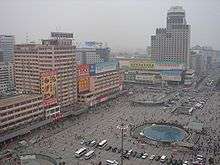
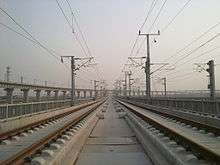
Zhengzhou, where the Longhai Railway (Lianyungang, Jiangsu–Lanzhou, Gansu) meets the Beijing–Guangzhou Railway, is a major national railway hub.[29] It is located on the Shijiazhuang–Wuhan High-Speed Railway and Xuzhou–Lanzhou High-Speed Railway and is easy to reach by high-speed train from Beijing (2.5 hours) Hong Kong (7 hours) and Xi'an (2 hours) and by normal train from Shanghai (6–14 hours).
The high-speed railway network provides fast train service from the city to Beijing, Shanghai, Nanjing, Xi'an and Wuhan at a speed of 350 km/h (220 mph). The new high-speed Zhengzhou East Railway Station is one of the largest in Asia.
Proposed high-speed railway connections between Zhengzhou and Chongqing, Jinan, Hefei, and Taiyuan are under discussion.
Zhengzhou North Railway Station (郑州北站), over 6,000 m long and over 800 m wide, has been described as Asia's largest marshalling yard[30]
Highways
The surrounding area of Zhengzhou, along with the Yangtze River Delta, Pearl River Delta and the Bohai Economic Rim, has the highest highway density nationwide. Zhengzhou is the center of Henan highway network that provides roughly one hour road trip to the surrounding cities of Kaifeng, Xinxiang, Xuchang, Jiaozuo and Luoyang. Other major cities within the province can be reached in 3 hours. National highway network also links Zhengzhou to all major cities in the country.
Bus
The first project of Zhengzhou Bus Rapid Transit (BRT) System was completed in 2009, which provides a 30 kilometres (19 miles) long circle line (B1) along the Second Ring Road in the city. The BRT B1 buses run on exclusive lanes at both clockwise and anti-clockwise directions. There are branch BRT routes (B11 to B19) linking B1 route and other important part of the city.
Air
Zhengzhou Xinzheng International Airport is 37 km (23 mi) southeast of the city centre.
The airport was the headquarters for Henan Airlines and also a focus city of China Southern Airlines and Shenzhen Airlines
Subway
The plans of Zhengzhou Metro lines 1 and 2 were approved by the National Development and Reform Commission in Feb. 2009.[31] Zhengzhou Subway will be a rapid transit rail network that serves both the urban and suburban districts of Zhengzhou municipality. As planned, those two projects will start from 2009 and will be finished in 2013 and 2015 respectively.[32] As referenced in the long term plan, there are another 4 lines pending approval,[33] Line 3 and Line 4 will be under construction during 2015-2020 and will be in operation by 2020, construction of Line 5 and Line 6 will begin in 2020.[34]
Colleges and universities
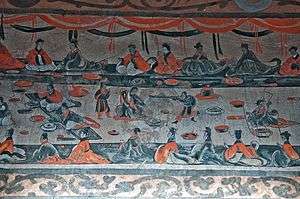
Public
- Zhengzhou University
- Henan Agricultural University
- Henan University of Technology (formerly Zhengzhou Institute of Technology)
- Henan University of Finance and Economics
- Zhongyuan Institute of Technology
- Zhengzhou University of Light Industry
- Zhengzhou Institute of Aeronautical Industry Management
- North China Institute of Water Conservancy and Hydroelectric Power
- Henan University of Traditional Chinese Medicine
- Henan Textile University (河南纺织专科学校)
- Henan Normal University
Military
- Information Engineering University of People's Liberation Army (解放军信息工程大学)
- Air Defense Force Command Academy
Private
- Zhengzhou College of Economics
- Huanghe S&T University
- Sias International University
- Shengda Economics, Trade and Management College of Zhengzhou
Notable people
- Bai Juyi 白居易 (772–846), Tang dynasty poet widely known for his poems featuring realism.
- Deng Yaping 邓亚萍 (1973– ), a four-time table tennis Olympic champion who later became a businesswoman.
- Du Fu 杜甫 (712–770), Tang dynasty poet, born in Gongyi, now a county under the administration of Zhengzhou.
- Wei Wei 魏巍 (1920–2008), modern era writer, widely known in China for his works on the Chinese Volunteer army's participation of the Korean War.
- Hai Xia 海霞 (born 1972), Chinese news anchor for China Central Television, the main state announcer of China.
- Han Fei 韩非(ca. 280 BCE - 233 BCE), also known as Han Feizi, an influential political philosopher of the Warring States Period.[35]
Politics
The current mayor is Wu Tianjun from February 2006.
List of the CPC Party Chiefs of Zhengzhou:
- Gu Jingsheng (谷景生): October 1948-December 1948
- Wu Defeng (吴德蜂): December 1948-June 1949
- Zhao Wucheng (赵武成): June 1949 - April 1953
- Song Zhihe (宋致和): April 1953-August 1956
- Wang Lizhi (王黎之): August 1956-January 1968
- Wang Hui (王辉): March 1971-January 1974
- Zhang Junqing (张俊卿): January 1974-December 1977
- Yu Yichuan (于一川): December 1977-December 1979
- Li Baoguang (李保光): December 1979-May 1983
- Jiang Jinfei (蒋靳非): May 1983-September 1984
- Yao Minxue (姚敏学): September 1984-August 1987
- Cao Lei (曹磊): August 1987-July 1990
- Song Guochen (宋国臣): July 1990-May 1992
- Zhang Deguang (张德广): May 1992-December 1995
- Wang Youjie (王有杰): December 1995-June 2001
- Li Ke (李克): June 2001-
See also
- Zhengzhou Shang City
- History of Zhengzhou
- List of historical capitals of China
- Zhengzhou Ferris Wheel
- Zhengzhou Foreign Language School
Notes
- ↑ "郑州常住人口937.8万人居全省第二位". Retrieved 2016-03-13.
- ↑ "Illuminating China's Provinces, Municipalities and Autonomous Regions". PRC Central Government Official Website. Retrieved 2014-05-17.
- ↑ 郑州市情 (in Chinese). 商都网. 2009-05-25.
- ↑ "郑州市统计局". www.zzstjj.gov.cn. Retrieved 2016-02-13.
- 1 2 素芳, 焦 (18 May 2011). 郑州常住人口860多万 这是个啥概念 (in Chinese). 大河网. 河南商报. Retrieved 17 July 2015.
- ↑ Supersized cities: China’s 13 megalopolises
- ↑ Liu Yue (劉岳) (2007). "Investigating the Reasons for Tang of Shang's Fortifications at Zhengzhou (商湯在鄭州筑城建都的原因追蹤)《尋根》". Xun Gen (尋根) (in Chinese). Zhengzhou Publishing. 5. ISSN 1005-5258.
- ↑ A H Dani (1992), Critical Assessment of Recent Evidence on Mohenjo-daro, Second International Symposium on Mohenjo-daro, 24–27 February.
- ↑ "Henan's 3,600 Year-old Metropolis (豫现3600年前世界大都市)" (in Chinese). Henan Weiwenpo (文汇报). December 24, 2010. Retrieved February 7, 2012.
- ↑ Zhengzhou Region Historical Records Committee Compilation (郑州市地方史志编纂委员会) (in Chinese). Zhongzhou Antiquarina Book Publishing (中州古籍出版社). 1999. ISBN 7-5348-1869-9.
- 1 2 隞都郑州与郑州小双桥遗址 (in Chinese).
- ↑ Epstein, Israel (2005). History Should Not Be Forgotten. China Intercontinental Press. p. 70. ISBN 978-7-5085-0694-4.
- ↑ "Archived copy". Archived from the original on March 18, 2013. Retrieved February 18, 2013.
- ↑ 经书威、郑州市地方史志办公室 (2002). 《郑州大辞典》. 中州古籍出版社. ISBN 978-7-5348-1822-6.
- ↑ 中国地面国际交换站气候标准值月值数据集(1971-2000年) (in Chinese). China Meteorological Administration.
- ↑ "郑州城市介绍以及气候背景分析". 中国天气网 (in Chinese). 中国气象局公共气象服务中心. Retrieved 27 July 2015.
- ↑ Bildner, Eli (February 27, 2013). "Interactive Maps of China's Most–and Least–Polluted Places". Global Voices China. http://newsmotion.org. Retrieved 1 September 2014.
- 1 2 "Greenpeace ranks 360 Chinese cities by PM2.5 Air Pollution". Greenpeace. 2015-03-24.
- ↑ China's Shaolin Temple, Danxia Landform Added To World Heritage Sites
- ↑ "郑州GDP4000亿意味着什么" (in Chinese). CNTV. 2011-03-24.
- ↑ (Chinese) General information of Zhengzhou Archived May 25, 2008, at the Wayback Machine., Zhengzhou Government official website.
- ↑ Henan Shaolin Auto Co., Ltd. Archived June 22, 2009, at the Wayback Machine.
- ↑ http://www.stockmarketwire.com/article/3957438/Nissan-increases-production-capacity-in-China.html
- ↑ "Zhengzhou New Area". Retrieved 1 Nov 2009.
- ↑ (Chinese) "郑州的往世今生:50年考古确认中国第一古都" 新浪网 sina.com.cn Sep. 22, 2005
- ↑ RightSite.asia | Zhengzhou Hi-Tech Industrial Development Zone
- ↑ RightSite.asia | Zhengzhou Economic and Technological Development Zone
- ↑ RightSite.asia | Zhengzhou Export Processing Area
- ↑ "Zhengzhou, City Information of Zhengzhou, Zhengzhou Capital City of Henan Province". www.chinatoday.com. Retrieved 2015-05-22.
- ↑ 郑州北站---亚洲最大的列车编组站 Archived May 31, 2016, at the Wayback Machine. (Zhengzhou North Railway Station -- Asia's largest marshalling yard), 2016-04-08
- ↑ (Chinese) "郑州地铁获国务院批准 每公里成本近6亿今年开工" 河南日报大河网 Dahe.cn Feb. 13, 2009
- ↑ (Chinese) "地铁未来将出现在郑州市" 中广网 CNR.cn Feb. 13, 2009
- ↑ (Chinese) "国务院批准郑州地铁建设 6条地铁轨道线走向" 大河网 Dahe.cn Feb. 13, 2009
- ↑ (Chinese) "郑州地铁规划获国务院批准" 大河网 Dahe.cn Feb. 13, 2009
- ↑ "韩非 - 郑州市人民政府". www.zhengzhou.gov.cn. Retrieved 2015-11-10.
External links
| Wikimedia Commons has media related to Zhengzhou. |
| Wikivoyage has a travel guide for Zhengzhou. |
- Zhengzhou Government website (Chinese)
| Largest cities or towns in China Sixth National Population Census of the People's Republic of China (2010) | |||||||||
|---|---|---|---|---|---|---|---|---|---|
| Rank | Name | Province | Pop. | Rank | Name | Province | Pop. | ||
 Shanghai .jpg) Beijing |
1 | Shanghai | Shanghai | 20,217,700 | 11 | Foshan | Guangdong | 6,771,900 |  Chongqing 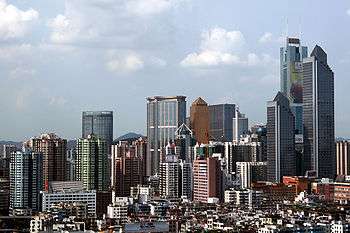 Guangzhou |
| 2 | Beijing | Beijing | 16,858,700 | 12 | Nanjing | Jiangsu | 6,238,200 | ||
| 3 | Chongqing | Chongqing | 12,389,500 | 13 | Shenyang | Liaoning | 5,890,700 | ||
| 4 | Guangzhou | Guangdong | 10,641,400 | 14 | Hangzhou | Zhejiang | 5,578,300 | ||
| 5 | Shenzhen | Guangdong | 10,358,400 | 15 | Xi'an | Shaanxi | 5,399,300 | ||
| 6 | Tianjin | Tianjin | 10,007,700 | 16 | Harbin | Heilongjiang | 5,178,000 | ||
| 7 | Wuhan | Hubei | 7,541,500 | 17 | Dalian | Liaoning | 4,222,400 | ||
| 8 | Dongguan | Guangdong | 7,271,300 | 18 | Suzhou | Jiangsu | 4,083,900 | ||
| 9 | Chengdu | Sichuan | 7,112,000 | 19 | Qingdao | Shandong | 3,990,900 | ||
| 10 | Hong Kong | Hong Kong | 7,055,071 | 20 | Zhengzhou | Henan | 3,677,000 | ||
